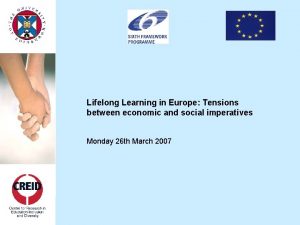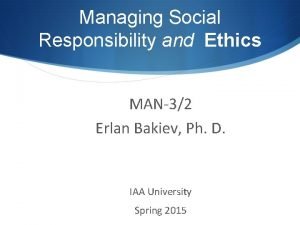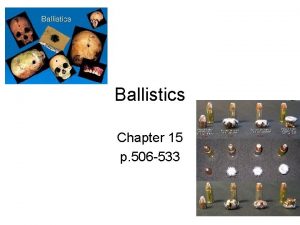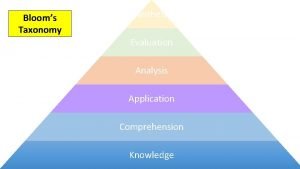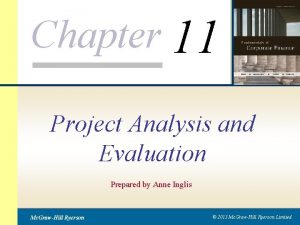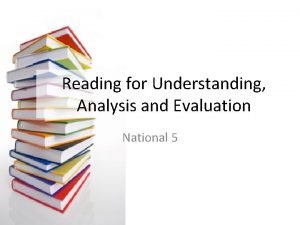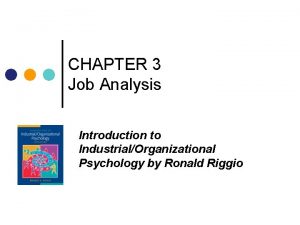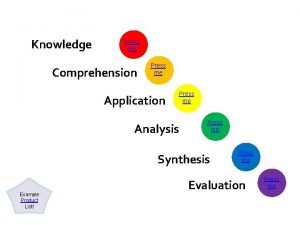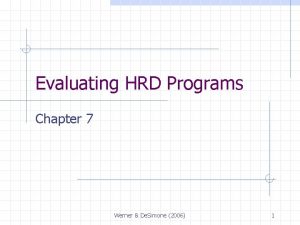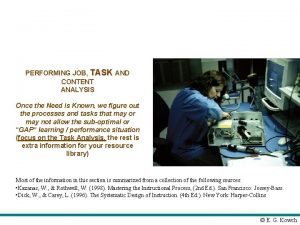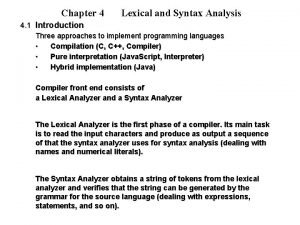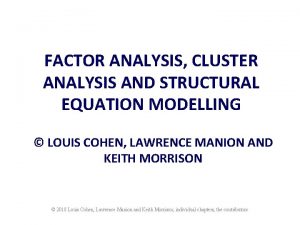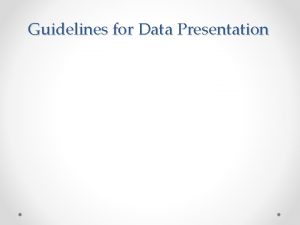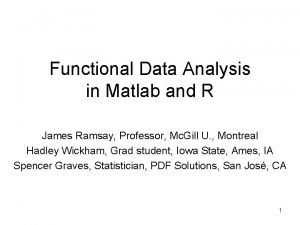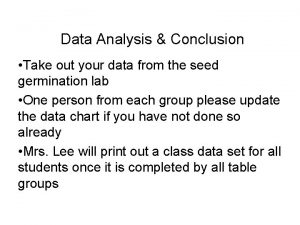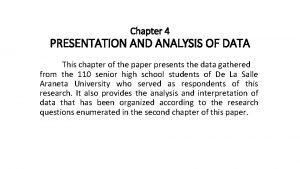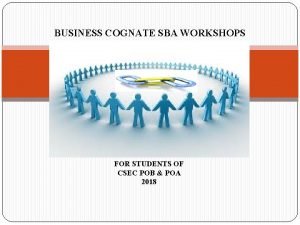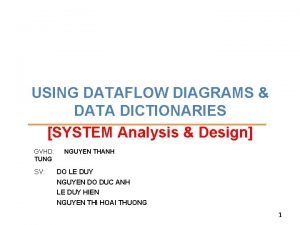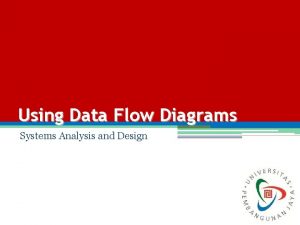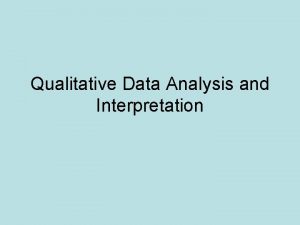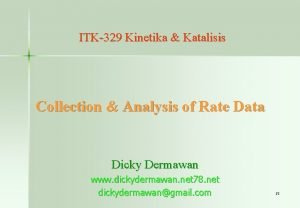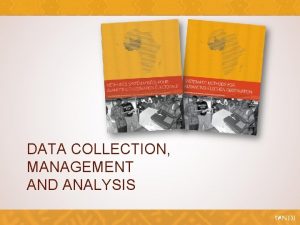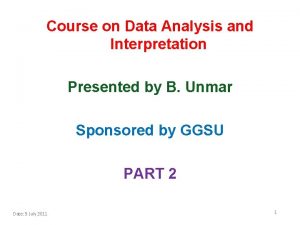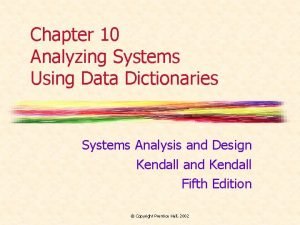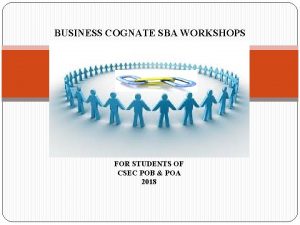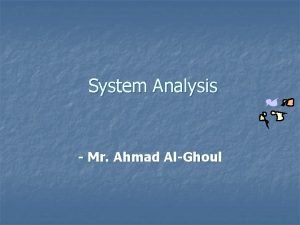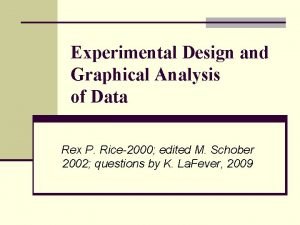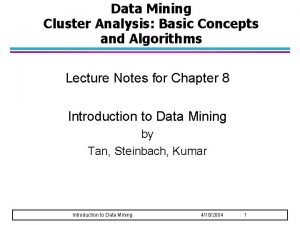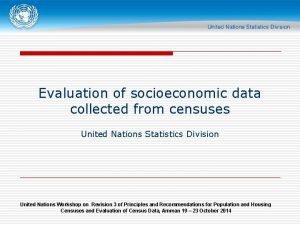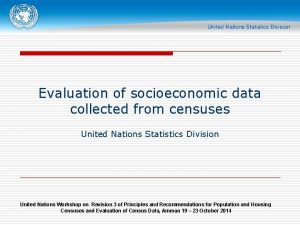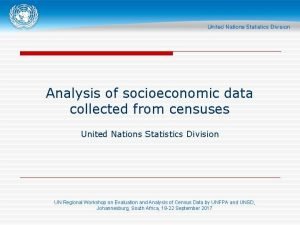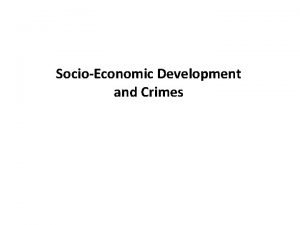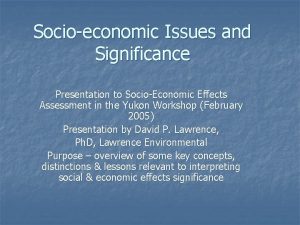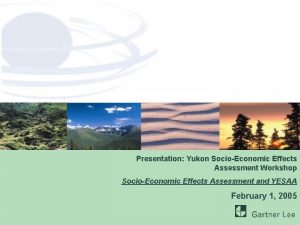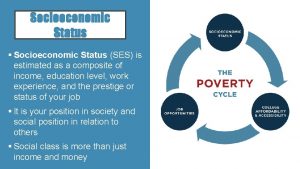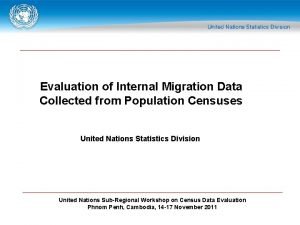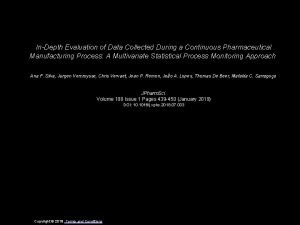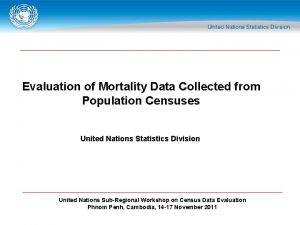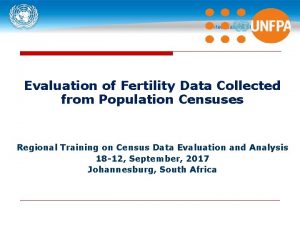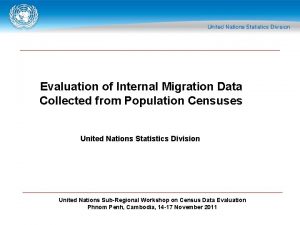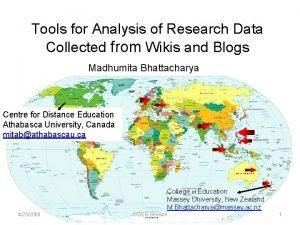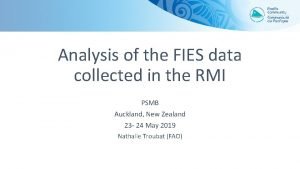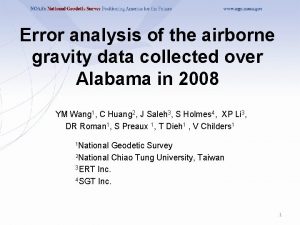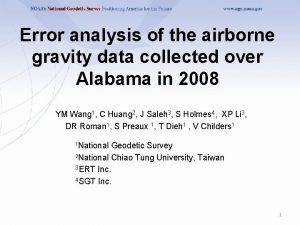Evaluation and analysis of socioeconomic data collected from





















































- Slides: 53

Evaluation and analysis of socioeconomic data collected from censuses United Nations Statistics Division

Socioeconomic characteristics q Household and family composition q Educational characteristics § § § Literacy School attendance Educational attainment q Marital status q Economic characteristics § Economic activity (labor force participation) § Status in employment Core topics from the Principles and Recommendations for Population and Housing Censuses, Rev. 2

Household population q The concept of household is based on the arrangements made by persons, individually or in groups, for providing themselves with food and other essentials for living n A household may be either (a) a one-person household, a person who makes provision for his or her own food and other essentials for living without combining with any other person to form a multiperson household or n a multi-person household, that is to say, a group of two or more persons living together who make common provision for food and other essentials for living o The persons in the group may pool their resources and may have a common budget; they may be related or unrelated persons or constitute a combination of persons both related and unrelated United Nations Workshop on Revision 3 of Principles and Recommendations for Population and Housing Censuses and Evaluation of Census Data, Amman 19 – 23 October 2014

Institutional population q The institutional population comprises persons who are not members of households and living in military installations, correctional and penal institutions, dormitories of schools and universities, religious institutions, hospitals and others q Personnel responsible for the running of an institution and not living in dormitories or similar accommodations should be excluded from the institutional population United Nations Workshop on Revision 3 of Principles and Recommendations for Population and Housing Censuses and Evaluation of Census Data, Amman 19 – 23 October 2014

Household and family composition q The family within the household is defined as those members of the household who are related, to a specified degree, through blood, adoption or marriage q The differences between the household and the family are that: n n household may consist of only one person but a family must contain at least two members, the members of a multi-person household need not be related to each other, while the members of a family must always be related

How to analyze household characteristics q q q Distribution of the households by size Average household size Distribution of households by composition n One-person household n Nuclear household, consisting a single family nucleus, n Extended household, single family nucleus with other related persons, more than one nucleus family, etc. n Composite household, a single family nucleus with other non-related persons, two or more people related to each other but not family nucleus Source: UN Principles and recommendations

How to analyze household characteristics q Nuclear household, defined as a household consisting entirely of a single family nucleus: (i) Married-couple family: a. With child(ren) b. Without child(ren) (ii) Partner in consensual union (cohabiting partner): a. With child(ren) b. Without child(ren) (iii) Father with child(ren) (vi) Mother with child(ren) Source: UN Principles and recommendations

Household composition, Myanmar q 1. 2. 3. 4. 5. 6. Relationship to the head of household Head 7. Siblings Spouse 8. Grandparent Son/daughter 9. Other relatives Son-daughter in law 10. Adopted child Grandchild/Great grandchild 11. Non relative Parents/parents in law United Nations Workshop on Revision 3 of Principles and Recommendations for Population and Housing Censuses and Evaluation of Census Data, Amman 19 – 23 October 2014


Average HH size: Household population/ Number of households


United Nations Workshop on Revision 3 of Principles and Recommendations for Population and Housing Censuses and Evaluation of Census Data, Amman 19 – 23 October 2014

Average HH Size, Myanmar Percentage distribution of households by size, Myanmar 25 1 20 2 15 3 4 10 5 6 5 7+ 0 1983 Census 1997 FRHS 2001 FRHS 2007 FRHS Average size 1983 census: 5. 2 1997 FRHS: 5. 0 2001 FRHS: 5. 2 2007 FRHS: 4. 9

Education q Three core concepts; n Literacy – ability to read and write a short, simple statement n School attendance – current, regular attendance at an accredited educational institution or program o Distinguished from enrollment, which means that the student is officially registered at school, not necessarily that s/he actually goes to class n Educational attainment – highest grade completed within the most advanced level reached in the educational system

Education q How to evaluate the quality of data: n Cohort analysis n Comparison of education indicators calculated from the census and other sources of data –household surveys, administrative registers

Cohort approach q Use the demographic concept of birth cohort to generate time series data for people who were born in the same year/period by their completed level of education and literacy q Analyze successive census data by cohorts - if they show the same or similar number/percentage for certain level of education while age increases q Assumptions: n n Population size changes with births and deaths only – no migration People do not continue education after reaching certain age - based on educational system in a country

Cohort approach q Data requirement : Consecutive population censuses by age groups, sex and literacy status and completed level of education Literate Population, Morocco, Male q Example for two successive censuses conducted in 1994 and 2004 Age group 15 -19 20 -24 25 -29 30 -34 35 -39 40 -44 45 -49 50 -54 55 -59 60 -64 65 -69 70 -74 1994 Census 2004 Census 1, 001, 617 1319162 862, 136 1097725 606, 808 884574 498, 536 772151 436, 522 595152 354, 813 527018 192, 203 448700 134, 027 362123 99, 384 184222 74, 235 125762 40, 602 81536 27, 775 56054

Cohort approach Literate Population, Morocco, Male Age group 15 -19 20 -24 25 -29 30 -34 35 -39 40 -44 45 -49 50 -54 55 -59 60 -64 65 -69 70 -74 1994 Census 2004 Census 1, 001, 617 1319162 862, 136 1097725 606, 808 884574 498, 536 772151 436, 522 595152 354, 813 527018 192, 203 448700 134, 027 362123 99, 384 184222 74, 235 125762 40, 602 81536 27, 775 56054 Re- organization of data by birth cohorts Literate Population, Morocco, Male Age group 15 -19 20 -24 25 -29 30 -34 35 -39 40 -44 45 -49 50 -54 55 -59 60 -64 65 -69 70 -74 1994 Census 2004 Census Year of birth 1001617 1319162 1984 -89 862136 1097725 1979 -84 606808 884, 574 1974 -79 498536 772, 151 1969 -74 436522 595, 152 1964 -69 354813 527, 018 1959 -64 192203 448, 700 1954 -59 134027 362, 123 1949 -54 99384 184, 222 1944 -49 74235 125, 762 1939 -44 40602 81, 536 1934 -39 27775 56, 054 1929 -34

Cohort approach Impact of out-migration among literate population ?

Basic indicators q Adult literacy rate: Percentage of population aged 15 years and over who can both read and write n Literate pop. (15+)/ Total population (15+) q Youth literacy rate: Percentage of persons aged 15 -24 years who can both read and write in the population of that age group § Literate pop. (15 -24)/ Population aged 15 -24 q Age- specific literacy rate n Literate pop at age (X)/ Population at age X Source: Education Indicators Technical Guidelines, UNESCO, 2009

Adult literacy rate United Nations Workshop on Revision 3 of Principles and Recommendations for Population and Housing Censuses and Evaluation of Census Data, Amman 19 – 23 October 2014

Youth literacy rate United Nations Workshop on Revision 3 of Principles and Recommendations for Population and Housing Censuses and Evaluation of Census Data, Amman 19 – 23 October 2014


Cohort approach Educational attainment, Republic of Korea, 2000, 2005 and 2010 censuses

School attendance q Percentage of children attending school by age q Gross attendance ratio-by level of education n Total attendance in a specific level of education, regardless of age, express as a percentage of the eligible official school-age population corresponding to the same level of education in a given school year q Net attendance rate- by level of education n Attendance of the official age group for a given level of education expressed as a percentage of the corresponding population


Percentage of students attending school by age and sex, Myanmar, 1983 90. 00 80. 00 70. 00 60. 00 50. 00 40. 00 30. 00 20. 00 10. 00 5 6 7 8 9 10 11 12 13 14 15 Total 16 17 Male 18 19 20 21 22 23 24 25 26 27 28 Female United Nations Workshop on Revision 3 of Principles and Recommendations for Population and Housing Censuses and Evaluation of Census Data, Amman 19 – 23 October 2014 29

Gross attendance ratio : Gross attendance ratio at level of education h in the year t : Students at the level of education h in the year t : Population in age group a which officially corresponds to the level of education h in year t

Net attendance rate : Net attendance rate at level of education h in the year t : Students of the population of age group a at level of education h in the year t : Population in age group a which officially corresponds to the level of education h in year t


Marital status q Marital status is the personal status of each individual in relation to the marriage laws or customs of the country. The categories of marital status should at least include the following: n n n Single (never married) Married but separated-comprise both legally and de facto separated Widowed and not married Divorced and not married

Marital status 1994 Population and Housing Census of Tunisia Proportion of widowed men

Comparison with survey data § Very similar patter between the census and DHS § Slight difference in the last age group

Singulate Mean Age at First Marriage (SMAFM) q Technique for estimating the mean age at first marriage when actual dates of marriage are not available n a period measure (uses a synthetic cohort) q Very simple data requirements: n Total number of women by 5 -year age groups n Total number of ever-married women by 5 -year age groups

SMAFM calculation (1) PEMult Source: Wachter, Ken, Essential Demographic Methods, Data from United Nations Demographic Yearbook

SMAFM calculation (2) United Nations Workshop on Revision 3 of Principles and Recommendations for Population and Housing Censuses and Evaluation of Census Data, Amman 19 – 23 October 2014

SMAM, Myanmar, 1973 -2007 United Nations Workshop on Revision 3 of Principles and Recommendations for Population and Housing Censuses and Evaluation of Census Data, Amman 19 – 23 October 2014

Economic activity q Two concepts of the economically active population can be distinguished: (a) The usually active population, measured in relation to a long reference period such as a year (b) The currently active population (or, equivalently, the labour force), measured in relation to a short reference period such as one week or one day

Economic activity q q Current activity status – a person’s relationship to economic activity during a short reference period (typically a week) n Employed – a person who worked a defined, minimum amount of time over the reference period (may be as little as an hour) n Unemployed – a person who did not work the minimum amount of time during the reference period but was willing and able to work and looking for a job n Inactive (out of labor force)– a person who did not work the minimum amount of time during the reference period and did not want to work/was not looking for work Both the employed and the unemployed are economically active! n Employed + unemployed = labor force

Economic activity q q Usual activity status – The usually active population comprises all persons above a specified age whose main activity status, as determined in terms of the total number of weeks or days during a long specified period (such as the preceding 12 months or the preceding calendar year) was employed and/or unemployed n Usually employed population: number of weeks or days employed is more than unemployed n Usually unemployed population: number of weeks or days employed is less than unemployed Both the employed and the unemployed are economically active!

United Nations Workshop on Revision 3 of Principles and Recommendations for Population and Housing Censuses and Evaluation of Census Data, Amman 19 – 23 October 2014

Economic activity q Difficulties: n What does “work” mean? o Goods and services produced for the market o Goods produced for own-use (replacing need to buy on market) Ø In practice, this is quite difficult to measure, especially in areas with large agricultural or informal economies Ø Women’s home-based production in particular is often undercounted in surveys n What does “looking for a job” mean? o E. g. some persons may have registered at a government labor office months ago, but done nothing else. Are they looking for a job?

Available data in the 2014 census q Activity status-Q 22 n Employee (Government) n Employee (Private) n Employer n Own account worker n Contributing family worker n Sought work n Did not seek work n Full time student n Household work n Pensioner, retired and elderly person n Disabled n Other United Nations Workshop on Revision 3 of Principles and Recommendations for Population and Housing Censuses and Evaluation of Census Data, Amman 19 – 23 October 2014

Available data in the 2014 census q Employed 1. Employee (Government) 2. Employee (Private) 3. Employer 4. Own account worker 5. Contributing family worker q Unemployed 1. Sought work q 1. 2. 3. 4. 5. 6. Population not in labor force Did not seek work Full time student Household work Pensioner, retired and elderly person Disabled Other United Nations Workshop on Revision 3 of Principles and Recommendations for Population and Housing Censuses and Evaluation of Census Data, Amman 19 – 23 October 2014

Basic indicators q Labor force participation rate q Unemployment rate Source: Decent work indicators, Guidelines for producers and users of statistical and legal framework indicators, ILO Manual, Second version, 2013

Basic indicators q Age-specific labor force participation rate q Age specific unemployment rate

Labor force participation rate (%), Myanmar, 1983 90. 00 80. 00 70. 00 LFPR for working age population (10 -64) Male % 63. 09 Female % 34. 98 60. 00 50. 00 40. 00 30. 00 20. 00 10 -14 15 -19 20 -24 25 -29 30 -34 35 -39 40 -44 45 -49 50 -54 55 -59 60 -64 65+ Male Female

Labor Force Participation Rate, Myanmar 120. 00 100. 00 80. 00 60. 00 40. 00 20. 00 10 -14 15 -19 20 -24 25 -29 30 -34 35 -39 40 -44 45 -49 50 -54 55 -59 60 -64 65+ LFPR-1983 Census Male LFPR-2007 Survey Male LFPR-1983 Census Female LFPR-2007 Survey Female

Unemployment rate (%), Myanmar, 1983 6. 00 5. 00 4. 00 Unemployment rate for working age population 3. 00 2. 00 Male % 2. 00 Female % 1. 17 1. 00 0. 00 10 -14 15 -19 20 -24 25 -29 30 -34 35 -39 40 -44 45 -49 50 -54 55 -59 60 -64 65+ Male Female

Basic indicators q Employment to population ratio q EPR, Myanmar, 1983 Total : % 48. 07 Male : % 61. 83 Female: % 34. 57

Employment status q q q Status in employment refers to the type of explicit or implicit contract of employment with other persons or organizations Care should be taken to ensure that an economically active person is classified by status in employment on the basis of the same job(s) as used for classifying the person by “occupation”, “industry” and “sector” Recommended classification (a) Employees (b) Employers (c) Own-account workers (d) Contributing family workers (e) Members of producers’ cooperatives (f) Persons not classifiable by status

Percentage distribution of employment status, 1983 Census 60 50 Male 40 Female 30 20 10 w np a U oy pl Em id ee fa -G m ily ov e oo pe -C ee oy pl or ke r t ra rn m tiv en e e at riv -P ee oy pl Em Em O w n ac co un t Em w pl oy or ke r er 0 United Nations Workshop on Revision 3 of Principles and Recommendations for Population and Housing Censuses and Evaluation of Census Data, Amman 19 – 23 October 2014

Some remarks q Census results are closely connected with other areas of statistical activities, therefore supplementary information about the census should be provided to the users for clarification of comparability of census data with previous censuses and other data sources q Further analysis for interpreting the findings
 Words images objects qualitative or quantitative
Words images objects qualitative or quantitative Socioeconomic model
Socioeconomic model Socioeconomic examples
Socioeconomic examples The new status fridge
The new status fridge Socioeconomic view
Socioeconomic view ....is dreaming (george)
....is dreaming (george) Scientists recently discovered that rocks collected
Scientists recently discovered that rocks collected How are ballistics collected
How are ballistics collected Benefits of scanning in reading
Benefits of scanning in reading Define data collection method
Define data collection method Data preparation and basic data analysis
Data preparation and basic data analysis Data acquisition and data analysis
Data acquisition and data analysis Application synthesis
Application synthesis Project analysis and evaluation
Project analysis and evaluation Reading for understanding analysis and evaluation
Reading for understanding analysis and evaluation Data quality is always a concern with secondary data
Data quality is always a concern with secondary data Difference between job description and job specification
Difference between job description and job specification Job analysis vs job evaluation
Job analysis vs job evaluation Methods of job analysis in industrial psychology
Methods of job analysis in industrial psychology Knowledge application and analysis
Knowledge application and analysis Collecting highly parallel data for paraphrase evaluation
Collecting highly parallel data for paraphrase evaluation Data collection for hrd evaluation
Data collection for hrd evaluation Progress and performance measurement and evaluation
Progress and performance measurement and evaluation What is visitor pre registration in picme
What is visitor pre registration in picme Progress and performance measurement and evaluation
Progress and performance measurement and evaluation Define structured analysis.
Define structured analysis. Content and discourse analysis
Content and discourse analysis Difference between error analysis and contrastive analysis
Difference between error analysis and contrastive analysis Contrastive analysis error analysis and interlanguage
Contrastive analysis error analysis and interlanguage Fact finding in system analysis and design
Fact finding in system analysis and design Task analysis and content analysis
Task analysis and content analysis Lex
Lex Technical feasibility in system analysis and design
Technical feasibility in system analysis and design Kmo test
Kmo test Data presentation examples
Data presentation examples Confint matlab
Confint matlab Conclusion of data analysis
Conclusion of data analysis Data analysis qualitative
Data analysis qualitative Chapter four data presentation and analysis
Chapter four data presentation and analysis Business cognate sba topics
Business cognate sba topics Data dictionary in system analysis and design
Data dictionary in system analysis and design Data flow diagram in system analysis and design
Data flow diagram in system analysis and design System and form design example
System and form design example Example of analysis and interpretation of data
Example of analysis and interpretation of data Data analysis tricks
Data analysis tricks Collection and analysis of rate data
Collection and analysis of rate data Data collection management and analysis
Data collection management and analysis Example of analysis and interpretation of data
Example of analysis and interpretation of data Data dictionary example in system analysis and design
Data dictionary example in system analysis and design Pob sba background sample
Pob sba background sample Data dictionary example in system analysis and design
Data dictionary example in system analysis and design Experimental design and graphical analysis of data
Experimental design and graphical analysis of data Cluster data mining
Cluster data mining Bad research questions
Bad research questions

